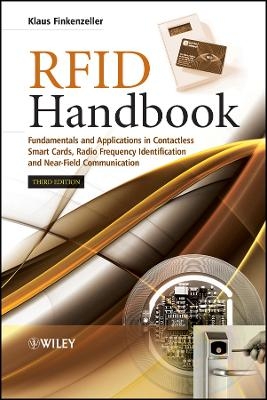
RFID Handbook – Fundamentals and Applications in Contactless Smart Cards, Radio Frequency Identification and Near–Field Communication 3e
Wiley-Blackwell (Hersteller)
978-0-470-66512-1 (ISBN)
- Keine Verlagsinformationen verfügbar
- Artikel merken
This is the third revised edition of the established and trusted RFID Handbook; the most comprehensive introduction to radio frequency identification (RFID) available. This essential new edition contains information on electronic product code (EPC) and the EPC global network, and explains near-field communication (NFC) in depth. It includes revisions on chapters devoted to the physical principles of RFID systems and microprocessors, and supplies up-to-date details on relevant standards and regulations. Taking into account critical modern concerns, this handbook provides the latest information on: * the use of RFID in ticketing and electronic passports; * the security of RFID systems, explaining attacks on RFID systems and other security matters, such as transponder emulation and cloning, defence using cryptographic methods, and electronic article surveillance; * frequency ranges and radio licensing regulations. The text explores schematic circuits of simple transponders and readers, and includes new material on active and passive transponders, ISO/IEC 18000 family, ISO/IEC 15691 and 15692. It also describes the technical limits of RFID systems.
A unique resource offering a complete overview of the large and varied world of RFID, Klaus Finkenzeller's volume is useful for end-users of the technology as well as practitioners in auto ID and IT designers of RFID products. Computer and electronics engineers in security system development, microchip designers, and materials handling specialists benefit from this book, as do automation, industrial and transport engineers. Clear and thorough explanations also make this an excellent introduction to the topic for graduate level students in electronics and industrial engineering design. Klaus Finkenzeller was awarded the Fraunhofer-Smart Card Prize 2008 for the second edition of this publication, which was celebrated for being an outstanding contribution to the smart card field.
Klaus Finkenzeller was awarded the Fraunhofer-Smart Card Prize 2008 for the second edition of this publication, which was celebrated for being an outstanding contribution to the smart card field.
Preface to the Third Edition List of Abbreviations 1 Introduction 1.1 Automatic Identification Systems 1.2 A Comparison of Different ID Systems 1.3 Components of an RFID System 2 Differentiation Features of RFID Systems 2.1 Fundamental Differentiation Features 2.2 Transponder Construction Formats 2.3 Frequency, Range and Coupling 2.4 Active and Passive Transponder 2.5 Information Processing in the Transponder 2.6 Selection Criteria for RFID Systems 3 Fundamental Operating Principles 3.1 1-Bit Transponder 3.2 Full- and Half-Duplex Procedure 3.3 Sequential Procedures 3.4 Near-Field Communication (NFC) 4 Physical Principles of RFID Systems 4.1 Magnetic Field 4.2 Electromagnetic Waves 4.3 Surface Waves 5 Frequency Ranges and Radio Licensing Regulations 5.1 Frequency Ranges Used 5.2 The International Telecommunication Union (ITU) 5.3 European Licensing Regulations 5.4 National Licensing Regulations in Europe 5.5 National Licensing Regulations 5.6 Comparison of National Regulations 6 Coding and Modulation 6.1 Coding in the Baseband 6.2 Digital Modulation Procedures 7 Data Integrity 7.1 The Checksum Procedure 7.2 Multi-Access Procedures - Anticollision 8 Security of RFID Systems 8.1 Attacks on RFID Systems 8.2 Protection by Cryptographic Measures 9 Standardisation 9.1 Animal Identification 9.2 Contactless Smart Cards 9.3 ISO/IEC 69873 - Data Carriers for Tools and Clamping Devices 9.4 ISO/IEC 10374 - Container Identification 9.5 VDI 4470 - Anti-theft Systems for Goods 9.6 Item Management 10 The Architecture of Electronic Data Carriers 10.1 Transponder with Memory Function 10.2 Microprocessors 10.3 Memory Technology 10.4 Measuring Physical Variables 11 Readers 11.1 Data Flow in an Application 11.2 Components of a Reader 11.3 Integrated Reader ICs 11.4 Connection of Antennas for Inductive Systems 11.5 Reader Designs 11.6 Near-Field Communication 12 The Manufacture of Transponders and Contactless Smart Cards 12.1 Glass and Plastic Transponders 12.2 Contactless Smart Cards 13 Example Applications 13.1 Contactless Smart Cards 13.2 Public Transport 13.3 Contactless Payment Systems 13.4 NFC Applications 13.5 Electronic Passport 13.6 Ski Tickets 13.7 Access Control 13.8 Transport Systems 13.9 Animal Identification 13.10 Electronic Immobilisation 13.11 Container Identification 13.12 Sporting Events 13.13 Industrial Automation 14 Appendix 14.1 Contact Addresses, Associations and Technical Periodicals 14.2 Relevant Standards and Regulations 14.3 Printed Circuit Board Layouts References Index
| Erscheint lt. Verlag | 14.6.2010 |
|---|---|
| Verlagsort | Hoboken |
| Sprache | englisch |
| Maße | 168 x 244 mm |
| Gewicht | 666 g |
| Themenwelt | Technik ► Nachrichtentechnik |
| ISBN-10 | 0-470-66512-2 / 0470665122 |
| ISBN-13 | 978-0-470-66512-1 / 9780470665121 |
| Zustand | Neuware |
| Informationen gemäß Produktsicherheitsverordnung (GPSR) | |
| Haben Sie eine Frage zum Produkt? |